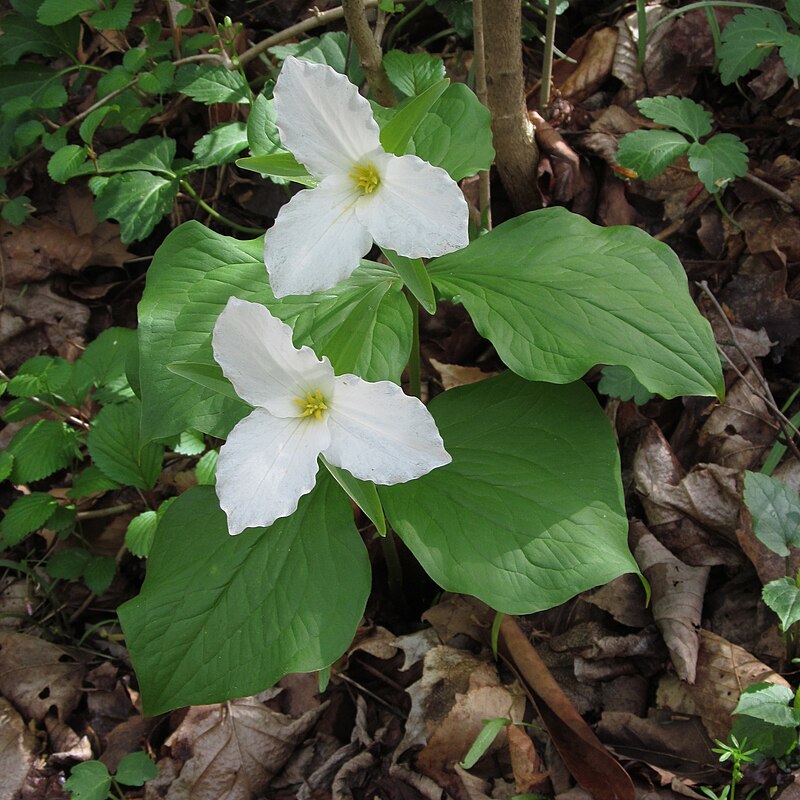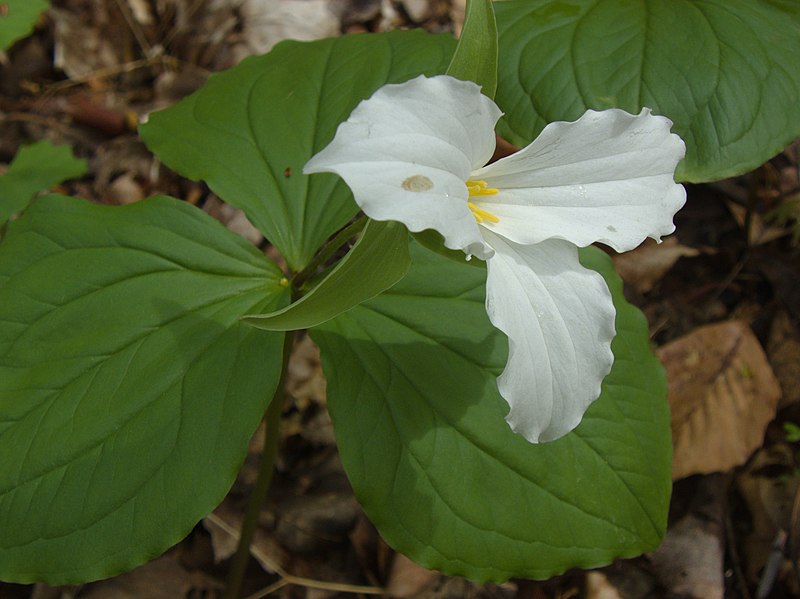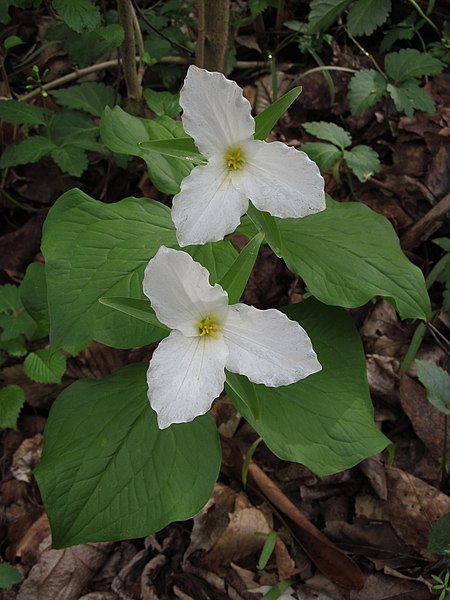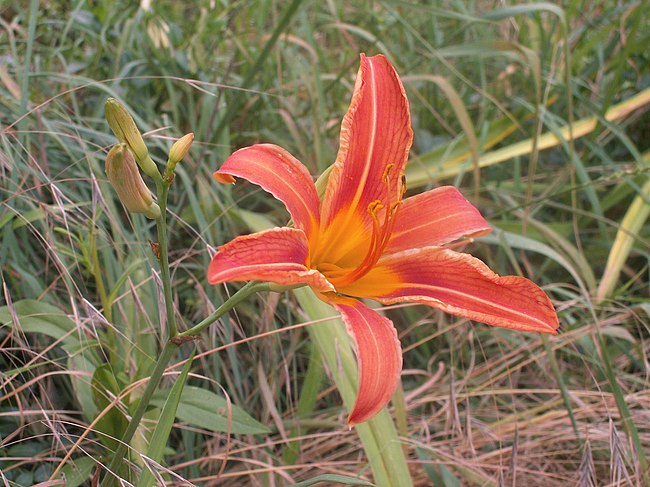
Great White Trilliums are out along the Trillium Trail in Fox Chapel. All the spring flowers are a little early this year.
For a detailed description, see the Trillium grandiflorum reference page.







Great White Trilliums are out along the Trillium Trail in Fox Chapel. All the spring flowers are a little early this year.
For a detailed description, see the Trillium grandiflorum reference page.







With the division of the Lily Family into many different families and even orders, modern botanists place Hemerocallis in the family Asphodelaceae in the order Asparagales.
This favorite garden perennial has naturalized itself quite successfully in western Pennsylvania, and huge colonies light up our roadsides in June. Countless variations have been bred for connoisseurs, but nothing matches the simple elegance of the original species. It is considered invasive by some people who worry about such things. These plants were blooming at the edge of an old German cemetery in Beechview.

Gray describes the genus and the species:
HEMEROCALLIS L. DAY LILY. Perianth funnel-form, lily-like; the short tube inclosing the ovary, the spreading limb 6-parted; the 6 stamens inserted on its throat. Anthers as in Lilium, but introrse. Filaments and style long and thread-like, declined and ascending; stigma simple. Capsule (at first rather fleshy) 3-angled, loculicidally 3-valved, with several black spherical seeds in each cell. Showy perennials, with fleshy-flbrous roots; the long and linear keeled leaves 2-ranked at the base of the tall scapes, which bear at the summit several bracted and large flowers; these collapse and decay after expanding for a single day (whence the name, from hemera, a day, and kallos, beauty.)
H. fulva L. (COMMON D.) Inner divisions (petals) of the tawny orange perianth wavy and obtuse. Roadsides, escaped from gardens. (Introd. from Eu.)

As Great White Trilliums age, they tend to take on rosy hues. We should all age so gracefully. This is what some of the trilliums on the Trillium Trail looked like in the middle of May, late in their season.



Gray describes the genus and the species:
TRÍLLIUM L. WAKE ROBIN. BIRTHROOT. Sepals 3, lanceolate, spreading, herbaceous, persistent. Petals 3, larger, withering in age. Stamens б; anthers linear, on short filaments, adnate. Styles awl-shaped or slender, spreading or recurved above, persistent, stigmatic down the inner side. Seeds ovate, horizontal, several in each cell. — Low perennial herbs, with a stout and simple stem rising from a short and praemorse tuber-like rootstock, bearing at the summit a whorl of 3 ample, commonly broadly ovate, more or less ribbed but netted-veined leaves, and a terminal large flower; in spring. (Name from tree, three; all the parts being in threes.) — Monstrosities are not rare with the calyx and sometimes petals changed to leaves, or the parts of the flower increased in number.
T. grandiflorum (Michx.) Salisb. Leaves less broadly rhombic-ovate; pedicel erect or ascending; petals oblanceolate, often broadly so (4-6 cm. long), white turning rose-color or marked with green; stamens with stout filaments (persistently green about the fruit) and anthers, exceeding the very slender erect or suberect and somewhat coherent stigmas; fruit subglobose. Rich woods, w. Que. and w. Vt. to Minn., Mo., and N. C.
 The Great White Trillium loves to grow in vast colonies. It’s not all that common, but when you do find a stand of them, it may cover acres, as it does here along the aptly named Trillium Trail in Fox Chapel, where these plants were all blooming in early May.
The Great White Trillium loves to grow in vast colonies. It’s not all that common, but when you do find a stand of them, it may cover acres, as it does here along the aptly named Trillium Trail in Fox Chapel, where these plants were all blooming in early May.
Sometimes a flower takes on a pink flush as it ages, as you see above.
Gray describes the genus and the species:
TRÍLLIUM L. WAKE ROBIN. BIRTHROOT. Sepals 3, lanceolate, spreading, herbaceous, persistent. Petals 3, larger, withering in age. Stamens б; anthers linear, on short filaments, adnate. Styles awl-shaped or slender, spreading or recurved above, persistent, stigmatic down the inner side. Seeds ovate, horizontal, several in each cell. — Low perennial herbs, with a stout and simple stem rising from a short and praemorse tuber-like rootstock, bearing at the summit a whorl of 3 ample, commonly broadly ovate, more or less ribbed but netted-veined leaves, and a terminal large flower; in spring. (Name from tree, three; all the parts being in threes.) — Monstrosities are not rare with the calyx and sometimes petals changed to leaves, or the parts of the flower increased in number.
T. grandiflorum (Michx.) Salisb. Leaves less broadly rhombic-ovate; pedicel erect or ascending; petals oblanceolate, often broadly so (4-6 cm. long), white turning rose-color or marked with green; stamens with stout filaments (persistently green about the fruit) and anthers, exceeding the very slender erect or suberect and somewhat coherent stigmas; fruit subglobose. Rich woods, w. Que. and w. Vt. to Minn., Mo., and N. C.
In Wild Flowers Every Child Should Know, Frederic William Stack gives us this description:
LARGE FLOWERED WAKE-ROBIN
Trillium grandiflbrum. Lily Family.
The Trilliums rank among the foremost of our native woodland wild flowers, and they possess an individuality that compares favourably with the exclusive traits of the Arbutus, the Gentians, the Lobelias, and the Orchids. This beautiful, large, white-flowered species is one of the choicest and best known of its family. It is found during May and June, in damp, rich woods, and grows from eight to eighteen inches high. The single, smooth, stout, juicy stalk terminates with a whorl of three large, handsome, broadly egg-shaped, triple-ribbed leaves which taper suddenly at the apex and are narrowed to a stemless base. They are loose-textured, prominently veined, and toothless. The large, waxy-white, solitary flower is borne on a short stem that springs upright from the centre of the leaves. The three thin, broad, strongly veined, and long-pointed petals are larger and much longer than the three spreading, green, lanceshaped sepals, and they turn outward with a large graceful curve. They are scentless, and as they age they become pink. The single berry is nearly black when matured. This showy-flowered Trillium ranges from Canada to Florida, and west to Minnesota and Missouri.
 A European native that has made itself quite at home here, Star of Bethlehem can often be found in weedy patches of low grass. Until it blooms, its narrow leaves are hard to distinguish from the grass around them. The six-pointed white flowers are unmistakable, with six yellow-tipped stamens whose flattened “filaments” seem to form a miniature duplicate flower inside the larger one. This plant was blooming in early May in the Allegheny Cemetery, where it is regularly mowed but seems not to care much.
A European native that has made itself quite at home here, Star of Bethlehem can often be found in weedy patches of low grass. Until it blooms, its narrow leaves are hard to distinguish from the grass around them. The six-pointed white flowers are unmistakable, with six yellow-tipped stamens whose flattened “filaments” seem to form a miniature duplicate flower inside the larger one. This plant was blooming in early May in the Allegheny Cemetery, where it is regularly mowed but seems not to care much.
Although most traditional references place the Star of Bethlehem in the lily family Liliaceae, modern botanists separate it into the asparagus family Asparagaceae.
Gray describes the genus and the species:
ORNITHÓGALUM [Tourn.] L. STAR OF BETHLEHEM. Perianth of 6 (white) spreading 3-7-nerved divisions. Filaments 6, flattened-awl-shaped. Style 3-sided; stigma 3-angled. Capsule roundish-angular, with few dark and roundish seeds in each cell, loculicidal. — Scape and linear channeled leaves from a coated bulb. Flowers corymbed, bracted; pedicels not jointed. (A whimsical name from ornis, a bird, and gala, milk.)
O. umbellàtum L. Scape 1-2.5 dm. high; flowers 5-8, on long and spreading pedicels; perianth-divisions green in the middle on the outside. — Escaped from gardens. (Introd. from Eu.)